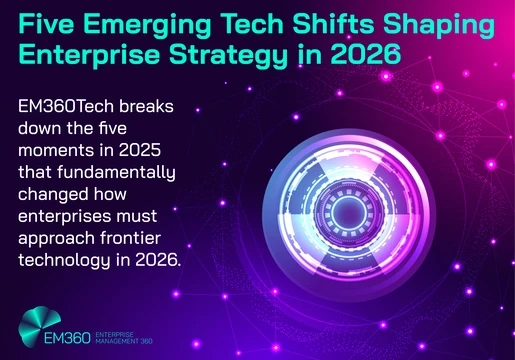The role of the CIO is becoming increasingly important to the modern day business; overseeing their entire technology stack in a bid to meet enterprise goals.

EM360's Matt Harris recently caught up with Saket Srivastava, Asana's newest CIO, about the modern Chief Information Officer and the challenges they face in today's world.
-
Matt: What are some of the biggest responsibilities and pain points for CIOs in today's world?
Saket: While many organisations face new uncertainty and resource constraints today, this is also a tremendous opportunity for CIOs to focus and invest in the initiatives that will drive longer term growth. Now is the time to double down on the work that will have the most impact in the long run.
With that comes a need for hyper-prioritisation. Too much time (as much as 60% of the working week in fact) is currently spent on ‘work about work’ – ongoing tasks such as status checks and unnecessary meetings. And this is exacerbated further by an increasing number of apps and disconnected tech stacks. Workers switch between as many as nine different apps daily, which drains focus and increases the risk of missing updates. It also creates confusion around who should be working on what, by when. What businesses require – and what CIOs should be prioritising – is an efficient tech stack that helps teams save time, maximise resources, track progress against goals, and ensure data security across distributed teams.
-
CIOs are responsible stewards of tech spend, and that's becoming more and more critical as the world navigates economic uncertainty. What are some of the financial challenges that CIOs face and how do they address them?
One of the biggest responsibilities that a CIO has is to be a mindful steward tech spend, something that is especially important during current economic uncertainty. This is a great opportunity for leaders to get organised and evaluate which tools are most critical to their teams. CIOs have a unique vantage point as we work cross-functionally and can see what tech is being adopted and actually utilised by various teams. It’s the role of IT leaders to champion tools that are the most effective in helping collaboration, productivity, and efficiency. That does not always mean reducing spend, but rather maximising and getting the most out of the technology you already have.
This is even more relevant to my team and the future of work space generally – as we can be part of the solution. During the pandemic there was a rush to make remote work a success, which resulted in the onboarding of lots of apps. Our recent Anatomy of Work Special Report found that overtooling is causing 23% of enterprise employees to be less efficient, 20% to have a reduced attention span, and 19% to miss messages. As CIOs, we can address this challenge by helping teams leverage the right tools and technology integrations to make work easier. This ultimately has a positive impact on the business, as well as employee wellbeing and productivity.
What do CIOs need to consider for their end of year planning?
For me, there are a handful of top priorities for CIOs in the year ahead. Firstly, it’s critical to get a pulse on customer needs and understand how they may be evolving as market conditions change. Secondly, CIOs must focus on improving their enterprise at the organisational level. That means putting in place the right tools to help teams focus on the company’s highest impact priorities and goals. Thirdly, there must be a focus on making collaboration more effective – this is critical in order to maximise resources and avoid costly redundancies.
At the technology level, there is also a need for CIOs to consider rapidly-evolving security challenges, growing automation, and the rising importance of data such as AI and machine learning. Optimisation will be key, not just in automation but also in human processes, so businesses can relieve pressure on the workforce.
-
How is tech evolving to keep up with the changes to the way we work, and what should CIOs prioritise so their organisation can adapt to this new era?
There is an ongoing trend toward more cross functional work, which demands technology that helps teams collaborate more efficiently. Employees used to have more narrow, clearly defined roles and responsibilities, but now work tends to be much more collaborative and integrated across functions, teams, and even geographies. Teams need tools that connect the work that’s being done to broader company goals and vision in real-time. Work management platforms are helpful because they create accountability and increase productivity by helping teams focus..
Ultimately, we need our digital tools to match the nature of today’s workplace – flexible and adaptable. Despite more digital tools at our disposal, many organisations have failed to ditch legacy standards that teams have come to accept as the norm – such as using spreadsheets to track project progress and spending too much time in status update calls. What we need is connection and clarity, and this means moving toward more purpose-built technology that can increase efficiencies across an organisation, power more effective cross-functional work, and decrease redundancies and errors.
-
How can CIOs make a difference in their organisation’s productivity, collaboration and decision-making?
The CIO's mandate is no longer back office operations and now includes connecting their organisation’s tech strategy with business strategy to move the company forward. In my opinion, the next phase of tech evolution and digital transformation is about maximising efficiencies without impacting the employee or customer experience.
Data from Asana’s Anatomy of Work study has revealed that enterprises could gain 33 working days per year by tackling inefficiencies and app overload. If CIOs want to make a difference in their organisation’s productivity, collaboration, and decision-making, they need to set up the right systems to enable their teams to work efficiently and cross-functionally without bottlenecks. This is where a work management platform comes in to automate ongoing tasks, freeing up employees to focus on meaningful work and reducing the amount of extra hours they’re taking on.
Work management platforms also support distributed teams which have become more common since the pandemic, so teammates across time zones and geographies can easily pick up on a project where their colleague left off. With streamlined processes, an organisation’s productivity, collaboration, and decision-making is made simpler and more effective.
-
What is your one secret to success as a CIO?
The secret to success for any CIO is simple – your teams. One of the most impactful investments that leaders can make in the year ahead is ensuring that employees have the tools to be engaged, efficient, and productive, as their ability to focus on work that drives meaningful results ultimately trickles down to the quality of the customer experience. In the coming year, having a real-time pulse on customer needs will be crucial as many organisations evaluate new priorities and uncertainty when it comes to long-term planning.







Comments ( 0 )